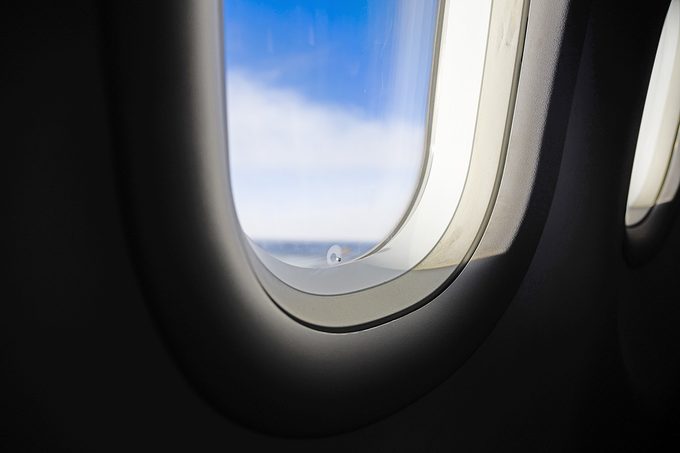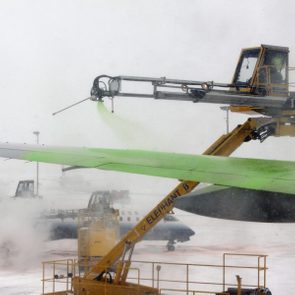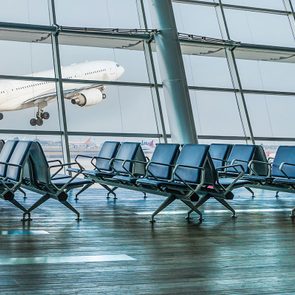They might look like a design quirk, but those holes at the bottom of airplane windows are actually doing a very important job

Here’s Why Some Airplane Windows Have Little Holes

At some point during my travels, I noticed airplane windows have those odd, tiny holes near the bottom. I came up with my own theory about what they must be there for and didn’t really think about it again, completely satisfied with my best guess.
Then my editors at Reader’s Digest asked me to check in with an aviation expert about the holes’ purpose. It turns out I was only partially right, and I missed the main point about why they’re there. As I learned, those forgettable little window features play an incredibly important role—and without them, modern aircraft could face serious issues.
Wayne Maltry, a consulting engineer at Engineering Design & Testing Corp. who specializes in the structural integrity of aircraft, walked me through why these often-overlooked airplane features are absolutely essential to a safe flight. Read on to find out why, and appreciate those little holes the next time you fly.
Get Reader’s Digest’s Read Up newsletter for more travel, humor, tech and fun facts all week long.
Why do airplane windows have little holes?

The tiny hole in an airplane window—known as a bleed hole or breather hole—allows air exchange between the window’s air gap and the cabin interior, preventing pressure imbalances.
To understand why this matters, Maltry explains how airplane windows, which are typically made up of multiple layers of a structural polymethyl-methacrylate acrylic, are constructed and installed. The outer layer is structural and must be sealed against the outside environment. A second structural layer, separated from the outer one by an air gap, acts as a fail-safe in case the outer layer is damaged or somehow compromised. There’s sometimes also a third, innermost layer that isn’t structural and exists to protect the other two layers from dirt, contaminants, scratches or other accidental damage from passengers.
Because modern aircraft fly at incredibly high speeds and altitudes, their ability to withstand pressure and its fluctuations is vital. (More on that below.) “The holes don’t regulate cabin pressure but instead regulate the rate of air pressure loading on the window glazings,” Maltry says.
As an example, the engineer compares regulating this pressure to dropping a hammer versus setting it down gently: “There is much less of an effect on the object if the hammer is laid on the object rather than dropped. In the same way, the window holes expose the structural glazings to gradual pressure changes, thus reducing the loading effect over time.”
Do the bleed holes serve any other purpose?
My (uneducated) guess was that the minuscule holes in airplane windows prevent condensation from building up between the layers. And while that’s actually true, the benefit is minor compared with the pressure issue.
“Condensation results from ambient moisture contact with cooler surfaces,” Maltry says. Since pressurized aircraft encounter frigid outside air at cruising altitude, the windows become extremely cold. Meanwhile, ambient moisture from inside the cabin—such as from passengers’ breath—can cause condensation on the interior surfaces of the window and decrease visibility. “The inner layer with bleed-hole arrangement reduces this effect,” Maltry explains.
What would happen if airplane windows didn’t have these holes?
“The most noticeable effect would be condensation on the window glazings, [which] would have a negative impact on visibility,” Maltry says.
You might think fogged-up windows would just be an annoying inconvenience for passengers, but they could become a very real safety concern. For starters, flight attendants wouldn’t be able to assess if there were external hazards like debris or fire during an evacuation or other emergency. Then, first responders outside the aircraft would have a harder time evaluating what’s happening inside.
The less noticeable but just as serious effect if windows didn’t have bleed holes? Long-term degradation of the window seals. “Air-pressure leaks would develop sooner and have a negative impact on window longevity,” Maltry says.
To grasp just how much of a problem this would be, it helps to return to Maltry’s hammer analogy. While gentle changes to air pressure wouldn’t cause a catastrophic event to the inner windows, the constant stress of abrupt or uneven changes would contribute to wear and tear and ultimately compromise windows’ structural integrity, just as repeatedly hitting the same spot with a hammer might lead to a breakdown in their structure.
Were airplane windows always made with holes?
No. According to Maltry, older or unpressurized aircraft, which flew at lower altitudes than modern jets, allowed for sufficient natural air exchanges to alleviate and manage interior pressure fluctuations and fogging. For that reason, window holes weren’t as necessary.
But that changed in the 1940s, when higher-flying planes created the need for pressurized cabins, beginning with the Boeing 307 Stratoliner. In the 1950s, the de Havilland Comet experienced a series of catastrophic accidents, and the planes’ failures were eventually traced back to square window corners that caused metal fatigue. Engineers then determined that rounded windows with bleed holes were necessary to reduce pressure issues and structural stress caused by repeated pressurization and depressurization cycles. That tiny tweak made—and continues to make—flying a lot safer.
RELATED:
- The Surprising Reason You Should Never Rest Your Head Against an Airplane Window
- Here’s Why Some Flags Are Painted Backward on Airplanes
- What Is the “Barking Dog Sound” on a Plane Before Takeoff?
About the expert
|
Why trust us
Reader’s Digest has published hundreds of travel stories that help readers explore the world safely, easily and affordably. We regularly cover topics such as the best places to visit (and the best times to visit them), tips and tricks to zoom through airport security, flight-attendant secrets, hotel-room hacks and more. We’re committed to producing high-quality content by writers with expertise and experience in their field in consultation with relevant, qualified experts. We rely on reputable primary sources, including government and professional organizations and academic institutions as well as our writers’ personal experiences where appropriate. We verify all facts and data, back them with credible sourcing and revisit them over time to ensure they remain accurate and up to date. Read more about our team, our contributors and our editorial policies.
Sources:
- Wayne Maltry, consulting engineer at Engineering Design & Testing Corp.; email interview, June 2025
- Association of Flight Attendants: “When Seconds Count: A Clear View Matters for Safety”
- History Link: “Boeing 307 Stratoliner Pressurized Airliner”
- The Guardian: “Tragedies That Changed Air Travel”























